Mothra (1961)
Directed by: Ishirô Honda
Written by: Shinichi Sekizawa, Shinichiro Nakumura, Takehiko Fukunaga, Yoshie Hotta
Starring: Frankie Sakai, Hiroshi Koizumi, Ken Uehara, Kyoko Kagawa
JAPAN
AVAILABLE ON BLU-RAY: 16TH NOVEMBER, from EUREKA ENTERTAINMENT
RUNNING TIME: 101 min/ 90 min [US version]
REVIEWED BY: Dr Lenera
A typhoon causes a ship to run aground at Infant Island, a supposedly uninhabited site for atomic bomb tests by the country of Rolisica. A rescue party finds four sailors alive and strangely unafflicted with radiation sickness, which they attribute to the juice provided them by island natives. The story is broken by tenacious reporter Zenichiro Fukuda and his photographer Michi Hanamura, who infiltrate the hospital examining the survivors. The Rolisican Embassy responds by co-sponsoring a joint Japanese-Rolisican scientific expedition to Infant Island, led by the suspiciously secretive Clark Nelson. There, they find two young women who are only twelve inches tall. Nelson kidnaps them and puts them in a show back in Tokyo, but the natives call upon their god Mothra to help, and a huge egg begins to hatch….
Despite my great love for Godzilla which most regular readers of HCF will know of by now, there are times when I think I love Mothra as much as my favourite Big G movies, and I believe that it is one of the very best of Toho’s monster movies. It’s a wildly imaginative melding of science-fiction with fairytale-like elements, and it manages to incorporate concerns which are still timely now such as big business, capitalism, racism, the destruction of nature and exploitation, yet never once loses focus of its compelling story. It was the first kaiju eiga to be aimed at family audiences, and the first to contain a somewhat sympathetic monster who would leave the end of the film in peace, but has none of the goofy [if infectious] silliness of some of the films to come. It was also uniquely Japanese in flavour, in a way that the proceeding Toho monster movies like Godzilla and Rodan, which were influenced greatly by their American counterparts, didn’t try to be so much, even if it does have many similarities with the British Gorgo which concerned a Godzilla-like beast rampaging through London to rescue her daughter; Mothra was being conceptualised slightly before though so it’s doubtful that the makers of Gorgo knew about it. With a story whose moral is universal, Mothra represents everything that is great about Toho fantasy movies of the late 50’s and first half of the 60’s, definitely their Golden Age, when the studio, usually with Ishiro Honda as director, were almost consistently churning out vibrant, thrilling and unique pictures which make most American efforts of a similar nature seem dull by comparison. It’s original, exciting and spectacular!
By 1960, Toho had made four monster movies, but the last of them, 1959’s Varan The Unbelievable, had been a commercial disappointment, causing Toho to try something more ambitious. Novelist Shinichiro Nakumura was hired to write a story based on the idea of a giant moth, and got two other writers Takehiko Fukunaga and Yoshie Hotta to help him, each one writing one third of a treatment which was serialised in a magazine as The Luminous Fairies And Mothra. Screenwriter Shinichi Sekizawa, who’d already done three Tohos and went on to script many Godzilla films, simplified this into a script, almost entirely removing a heavy Christian element to the background of Infant Island and its inhabitants, politics involving Japan and Rosilica, as well as reducing the number of Shobijin, the tiny twin fairies, from four to two when Yumi and Emi Ito, two female pop singers known as The Peanuts, were cast. He also originally had one of the Shobijin fall for Fukuda; he was probably wise to remove this subplot. The climax originally happened in Kyushu and featured a plane crash, a pursuit of the villains who capture Shinji the young boy, and Mothra flying to save them, but Columbia, eager to distribute in the US the latest of what were becoming very profitable imports from Toho, asked for it to be relocated in Rosilica to give the film a more international feel, and the finale was re-filmed. Unsubstantiated rumours exist that Daiei, when they were making Gamera The Giant Monster, stole Toho’s blueprints for the Tokyo Tower model. Mothra was a huge hit and Mothra would quickly become Toho’s most popular monster after Godzilla and the most frequent one to reappear.
Here, it’s over a third of the movie before we see her, but it doesn’t matter as there’s enough intrigue and mystery, along with some reasonably interesting characters. The idea of a special jungle liquid was re-used by Sekizawa four times; here it seems to protect stranded sailors on Infant Island, and indeed its natives, from the effects of nuclear tests. Michi the heroine isn’t perfect, having no bones about using underhand means to get pictures for her newspaper, while her companion, Zenichiro the ‘Snapping Turtle’, played by a popular comedian of the time Frankie Sakai, seems jokey and upbeat to the point of annoyance, but later reveals great tenacity and even skill at fighting – though the scene in which the latter is shown is laughably bad and shouldn’t have been left in the film [Honda didn’t use stunt people for fights, and it shows!]. It soon becomes apparent that, unusually for these films, we have a human villain; Nelson, the financier of the expedition to Infant Island which finds a forest, an area of colourful mutated mold [!] in an almost psychedelic set, heiroglyphs, a native tribe, and two minute ladies who save Shin’ichi Chujo, the linguist who soon joins Michi and Zenichiro as the third main human character, from being eaten by a vampire plant. The Shobijin wish their island to be spared further atomic testing, but, after previously wondering exactly what he’s up to at first, we soon see Nelson reveal his true nature when, upon first sight of the Shobijin, he tries to kidnap them. A symbol of capitalism at its worst, he’s a nastier version of Carl Denham in King Kong and is played by Jerry Ito with a constant sneer on his face; he’s a bad guy who you just love to hate!
A return trip sees the Shobijin taken away and one of the natives shot, and then we get the long, teasing lead-in to Mothra’s appearance, beginning with the dying man crawling to an alter and crying “Mothra”. The natives sing and dance, falling rocks reveal an egg which takes ages to hatch. Eventually cracks appear and the huge caterpillar bursts out, almost perfect matting showing the creature emerging at the top of the frame and the dancing natives at the bottom. The Shobijin have to sing in a show back in Japan, and the scenes involving them are handled with an almost religious reverence, and the way that they never lose their temper and never seem to lose heart either is affecting, even while one is aware of the irony of the song that they’re publicly singing being a call to a great big creature to come and rescue them. Speeded-up organ works well as their native speech, even though there’s some confusion about ways of communication. Mothra heads for Tokyo to rescue the Shobijin, and we now see how different she is from the previous kaiju; she doesn’t want to cause destruction [and by extension kill thousands], but whatever’s in her way on her mission is an obstacle. Her emergence from her destroyed cocoon [proceeded by the third appearance of those fan favourite laser cannons the Markalites] is a moment of strange beauty, after which she flies to the capital city of Rolisica, where loads of cars are blown into the air from the beating of her wings. It’s a rather surreal sight and perfectly encapsulates the childlike wonder of Japanese monster movies.
It seems no longer fashionable to mock the special effects in these films which were made on far smaller budgets to comparable western productions. It’s quite obvious that the caterpillar has people inside it [six!] and the Mothra models differ slightly, but they sometimes have a strong visual impact; shots of the caterpillar swimming with her light illuminating a small area of the sea while intercut with the Shobijin singing show have a beauty to them. The dolls substituting for the Shobijin in some shots are surprisingly convincing, and we get an awe-inspiring shot of a model plane flying through a cloud. The only things that really let the side down to modern eyes are the huge amount of rushed-looking matte paintings which were never something which Toho licked in those days, and the frequent matting of people onto model work or other live action footage, some of them featuring what looks like shots actually taken in the US. Considering the huge amount of stuff that needed to be visualised by Toho’s effects man Eiji Tsuburaya, it’s still amazing what he achieved, and the direction by Honda matches this in some scenes like a rather balletic death for Nelson which has a genuine element of human fear and uses some interesting editing and angles to heighten the scene. A major set-piece involving the destruction of a dam is a brilliant combination of technical wizardry and expert direction, the editing smoothly tying together several different things happening at once, though what with the rescue of a baby accidently left in the path of the incoming water, it’s the only bit where some fear is attempted from the idea of this huge monster wrecking havoc. And that’s fine; we’re not supposed to be scared of Mothra.
The fictional country of Rolisica is a substitute for America, replete with a Manhattan-like skyline for its capital city New Kirk [ha ha] City, even though it seems to be near Japan! But there’s a purity and grace about the whole Mothra mythology which is extremely appealing. The slight Christian element that remains is possibly awkward, with a contrived moment where someone sees a church cross with the sun behind it and immediately thinks of Mothra’s symbol, though I eventually realised that said symbol more closely resembles the Celtic cross than the Christian one. The implication remains that western big business causes Mothra’s rampage and western religion partly, if not entirely, stops it. There are lots of other interesting ideas that are hinted at which make this film quite rich, and it even switches in genre at times, virtually becoming a musical at times, though it never loses its narrative drive even though some may find a sub-plot involving Chujo’s younger brother trying to save the Shobijin pointless. Our three heroes are all very likeable and Toho stalwarts Akihito Hirata and Kenji Sahara plus Takashi Shimura appear in cameos. Yuji Koseki wrote the score for Mothra after Toho’s usual composer Akira Ifukube turned it down saying he couldn’t write suitable music for the Shobijin, and it’s easily as good as Ifukube’s best work. His music, which sounds slightly more ‘western’ [which is probably why they left it intact for the American version] than Ifukube’s, seems to emphasis Mothra’s anxiety and determination, its epic feel tempered with subtle emotion. We also get the first utterance of the hugely catchy ‘Song of Mothra’, the tune of which will stick in your mind after your first viewing. It being played by church bells for no apparent reason is an especially strange but lovely touch. Charming, exciting and beguiling, Mothra is really rather wonderful.
Rating: 









SPECIAL FEATURES
Limited Edition Hardbound Slipcase [3000 copies]
Reversible poster featuring the film’s original US and Japanese poster artwork
Includes both Japanese and English versions of each film [101 mins & 90 mins respectively]
This is no doubt the best that Mothra has ever looked; the vivid colour schemes truly come to life and there’s plenty of detail. However, the huge amount of rear or front projection does make the picture more grainy than it normally would be in places, and there’s some notable print damage towards the end with lots of marks on the screen. This is of course beyond the control of Eureka, who have probably ported over Mill Creek’s Region A version for this release. At least there aren’t loads of white flashes during cuts due to deterioration on the edges of the prints as with some of the Godzilla films in the Criterion box set! Of course Hi-Definition reveals the artifice more, especially with regard to the painted backdrops, but this can’t be helped. Fans should still be happy anyway.
The eleven minute-shorter US version of Mothra is rather good and certainly no disgrace to the Japanese version. Generally scenes were slightly cut down and/or more tightly edited rather than being totally removed, making some sections of the film move a bit faster. The first encounter with the Shobijin was re-edited so the only shot of the fairies is when Chujo wakes up from his daze and seems to remember seeing them. It’s an interesting alternative version of the scene which works rather well. Sadly some special effects footage of Mothra destroying stuff in both caterpillar and moth forms was removed, a baffling decision, but it doesn’t really harm the film. Some re-naming was done too, with ‘Snapping Turtle’ becoming ‘Bulldog’, and Infant Island being altered to Beiru. The dubbing is about as good as you can get without actual Japanese people doing the voices, and, unusually for the time, the music score was left intact! If you think your kids won’t sit through lots of subtitles but really want them to see this film, this version is a decent alternative.
Original mono audio presentations (LPCM)
English subtitles (Japanese version) and English SDH [English version]
Brand new audio commentary with film historian and writer David Kalat
Eureka add three new special features to the one audio commentary on the Mill Creek [and previously on the Sony DVD]. The first is a new talk track from Kalat who also contributed tracks to Eureka’s releases of The H-Man and Battle In Outer Space, and this is by far the best. He begins with stating, “welcome to the most important and influential Japanese monster movie of all time”, then proceeds to back up that lofty but in my view true comment throughout much of what follows. He also clears up the mystery of whether Yoshie Hotta [one of the original writers] was a man or a woman, goes into considerable detail about script development, and describes an interesting-sounding TV series called Agon: Atomic Dragon which is basically Sekizawa’s version of the 1954 Godzilla, in what is a treasure trove of information and appreciation. I’ve seen Mothra several times, and never noticed that the 1976 King Kong borrowed an idea from it, even though I’ve already mentioned the specific moment in my review!
Audio commentary with authors and Japanese sci-fi historians Steve Ryfle and Ed Godziszewski
Heard over the US version, this was the audio commentary that was on the North American release, and what with two kaiju movie experts instead of one it’s even more packed with information, though there’s a bit more time spent on biographies which is one of my pet commentary dislikes. We get some on-set stories, like production manager Ken Narita hiding extra water tanks from Tsuburaya so the dam broke more impressively, learn about the amusing American promotion, and even hear interview snippets from DVD producer Michael French [quoting from a chat with Koizumi], Jerry Ito and extra Clifford Harrington who was in the final scene. The two even point out some flaws. However, they never seem to properly interact, as if they were in different rooms, and sound too much like they’re reading from notes. The detail in this track more than makes up for this though – but in this case I prefer Kalat’s track just a little.
Kim Newman on ‘Mothra’ – an interview with film critic and author Kim Newman on the history and legacy of Mothra [14 mins]
Kim Newman seems to be happy to talk about any film, any genre; here he shows a clear fondness for the kaiju eiga genre and loves Mothra for the exoticism of its mythology which later films developed, says how the Gamera films sort of tried to do what Mothra achieved, and points out that only the Ray Harryhausen films attempted to do what the Japanese monster movies did with regard to their monsters.
Stills Galleries featuring rare archival stills and ephemera
PLUS: A LIMITED EDITION 60-PAGE collector’s booklet featuring essays by Christopher Stewardson and Japanese cinema expert Jasper Sharp (Midnight Eye); a new interview with Scott Chambliss (production designer on 2019’s Godzilla: King of the Monsters); an extract from Steve Ryfle and Ed Godziszewski’s Ishiro Honda biography; and archival reviews and stills.
[3000 copies]
One of the pinnacles of Japanese fantasy cinema, hugely fun and hugely likeable whatever your age. Beat the lockdown blues and also treat your kids. Highly Recommended.

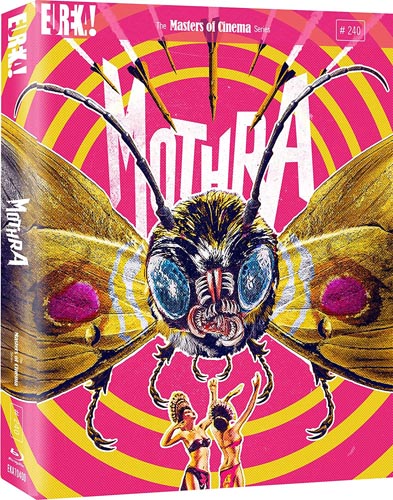
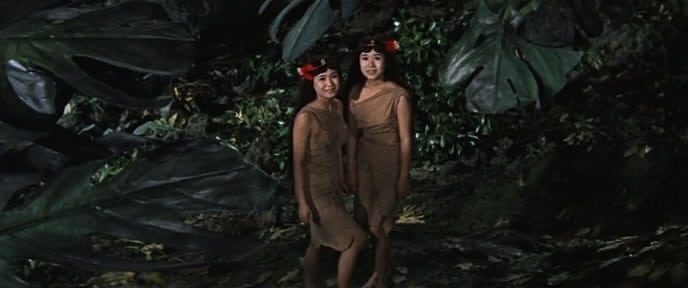
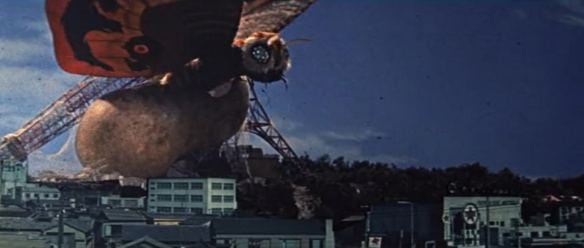

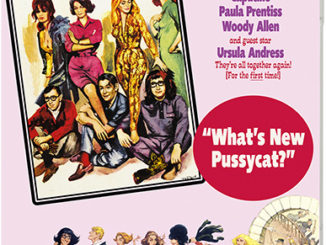
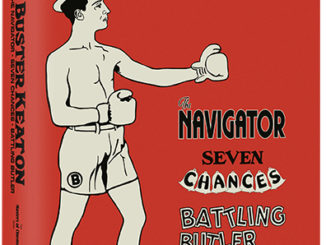

… un’altro da vedere!! interessante!